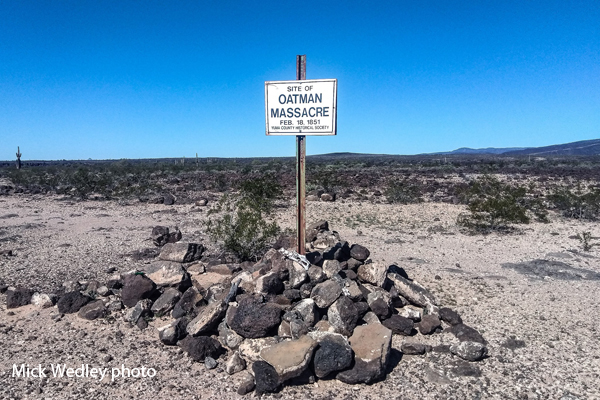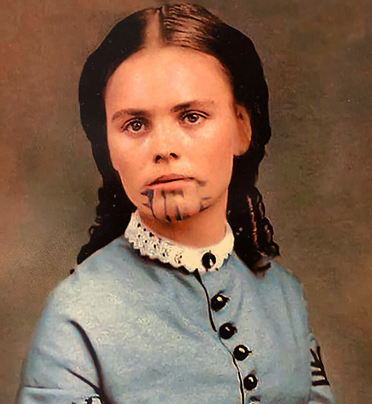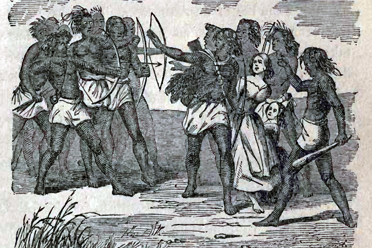Olive Oatman
1838 -1903In 1851, while on their way to California, a band of Tonto Apache masquerading as Puma Indians entered the Oatman family camp. After a few uneasy minutes, the Indians pulled out war clubs and with the exception of Olive, Mary Ann and Lorenzo, massacred the Oatman family. Brother Lorenzo's near dead body was thrown off a cliff with his dying mother, and listened to her sobbing while she and her newborn baby died.

Site of Oatman Massacre
Olive and Mary Ann Oatman were kidnapped,used as slaves, and a year later traded to Mohave Chief Espaniol for two horses, some vegetables, several pounds of beans and three blankets.
In the Mohave Indian village they were treated much better, but life was still hard. The younger, frail Mary Ann died in 1854, probably from malnutrition. Olive, at 16, was returned to her relatives in 1856.
The story made national headlines and raised a furor among non-Indians. The girls, from the Mojave point of view, were lucky to have fallen into their hands, away from the Tonto Apaches. Under the circumstances, they were fortunate. The chief attached them to his household, and they were afforded the best Mojave facilities, seeds for planting, love, divergence from Mojave customs. In any case, they would never be allowed to leave.
Title: The Captivating Story of Olive Oatman: A Symbol of Resilience and Cultural Adaptation
Introduction:
In the annals of American history, there are countless stories of individuals who have overcome adversity and left an indelible mark on society. One such individual is Olive Oatman, a woman whose life journey is as captivating as it is inspiring. From her captivating capture by Native Americans to her eventual return to white society, Olive Oatman's story serves as a testament to resilience, cultural adaptation, and the power of the human spirit.The Abduction:
Born in 1837, Olive Oatman grew up in rural Illinois, leading a relatively normal life until tragedy struck her family when she was just fourteen years old. In 1851, while traveling with her family through present-day Arizona, they were ambushed by a group of Yavapai Indians. Olive and her younger sister Mary Ann were taken captive while their parents and four other siblings tragically lost their lives.Life in Captivity:
For the next five years, Olive Oatman experienced a life drastically different from the one she had known. Living among the Mohave tribe, she adapted to their customs, language, and way of life. Olive's face became a symbol of her assimilation, as the Mohave people adopted the practice of tattooing her chin and arms, marking her as one of their own.The Return to White Society:
In 1856, Olive's remarkable journey took an unexpected turn when U.S. authorities discovered her during a Mohave tribe negotiation. After learning of her identity, efforts were made to reunite Olive with her remaining family members. Olive's return to white society was met with great curiosity and fascination, as her story captivated the nation.Legacy and Impact:
Olive Oatman's experiences left an indelible mark on her, shaping her worldview and influencing her perspective on cultural understanding and acceptance. After her return, she published a book detailing her captivity and challenges. This provided valuable insight into Native American culture and dispelled misconceptions prevalent at the time.Olive's story also served as a catalyst for discussions on the treatment of Native Americans and the importance of cultural sensitivity. Her resilience and ability to adapt to her surroundings continue to inspire individuals to embrace diversity and foster empathy.
Conclusion:
Olive Oatman's life journey, from abduction to assimilation and eventual reunion with white society, stands as a testament to the resilience of the human spirit. Her story serves as a reminder that even in the face of unimaginable hardship, one can find strength, adaptability, and the capacity to bridge cultural divides. Olive Oatman's legacy lives on, reminding us of the power of understanding, acceptance, and the triumph of the human spirit.

